Tools, parts and what you need for guitarmaking
-
Tools & Jigs
-
Tools
- Fretting Tools (Base)
- Pliers
- Sanding Blocks
- Brushes
- Files
- Routers
- Routing Templates
- Templates / Straight Edges
- Fretting Templates - Fret Scale Templates
- Clamps
- Knives
- Measuring Tools
- Tool Sets
- Reamer
- Keys, Wrenches
- Drill Jigs
- Saws
- Drill Bits
- Scrapers
- Bending Irons
- Other Tools
- Fret Hammer
- Fret Pressing
- Fretboard Protector
- Fret Bender & Tang Nipper
- ... More
- Jigs for Luthiers
-
Tools
-
Hardware & Parts
- Necks & Bodies
- Tuners
-
Hardware / Parts
- Truss Rods
- Carbon / Titan Reinforcement
- Trussrod Nuts
- Washer for truss rods
- Bridge Pins
- End Pins
- Bridges & Tailpieces E-Guitar
- Bridges & Tailpieces
- Covers
- Pickguards / Scratch Plates
- Strap Locks
- Bridge Accessories / Spare Parts
- Screws, Nuts, Washers
- Neck Attachement
- String-Ferrules
- Jack plates
- Control Plates
- String Retainer / String Trees
- knobs (pots/switch)
- Relic Parts
- ... More
- Nuts & Saddles
- Fret Wire
- Pickups & Electronics
- Materials & Supplies
- How-to
- Guitar Making
Shop Startpage Guitar Making Repairs Steelstring Repairs Hoefner 12-String
12-string Höfner built in 72 repair
Here I show the repair of a 12 sided Höfner with neck block problems (finger high string action)
This German piece of "vintage" guitar arrived in an externally well-preserved condition. First a few pictures to document that:
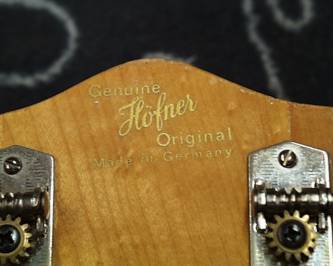 |
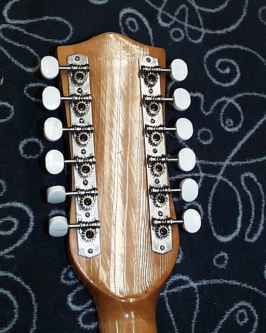 |
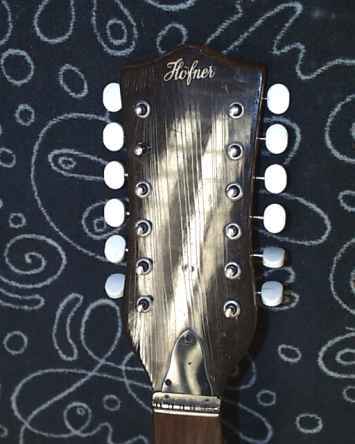 |
As is not uncommon with 12-string guitars, the enormous string tension directed the body. The string spacing was extremely high, you could easily get your pinky finger under it. The top was straight, the bridge was not loose either. What was strange, however, was the soft behavior of the neck at the body junction.
At that time, many models with screwed neck were on the market. This one had no visible neck screws but the neck was too soft and therefore could not be glued in! Below the neck foot was a 10mm thick hole with a M6 grub screw in it. It turned out that the grub screw did not serve to adjust the neck angle, but moved a hook that pulled the neck down and thus fastened it. I thought that with a wedge the whole thing was done - until I took the neck out and studied the damage.
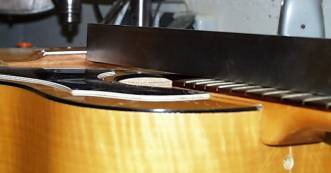 |
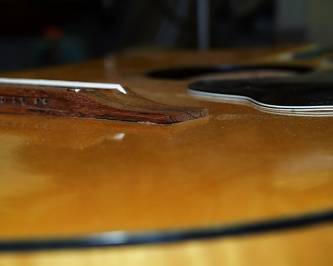 |
The string tension had compressed the top binding to 1/3 and pushed the remaining third into the top. When I removed the neck, an 8mm steel pin fell out. After wondering for a moment, I understood the construction. Said hook held the neck in place at the front, and the steel pin sat at the top of the neck block and dissipated the moment and force of the string pull into the wood block. The position of the steel pin slot thus determined the string action. Probably very soon after manufacture, the construction must have given way. It appeared that the entire neck block had detached from the rib and top at the top and front, making it understandable why the neck binding was so severely depressed. With the binding pressed in, the neck block itself had also sunk almost 3mm to the back. Now it was time to drink tea - what is the best way to repair it?
 |
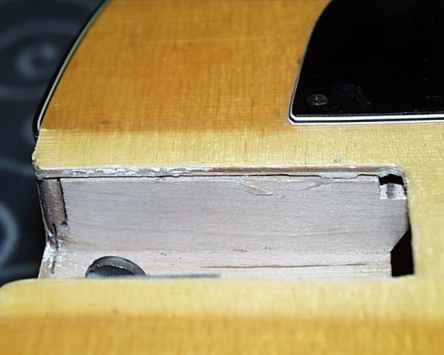 |
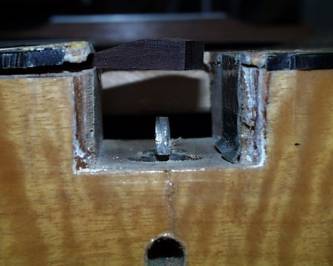 |
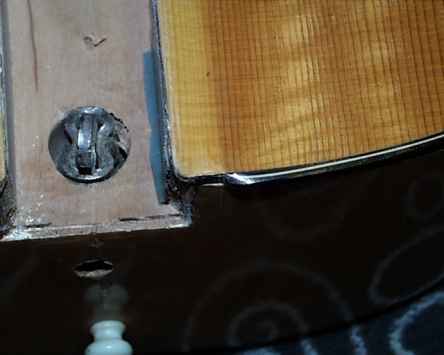 |
First I built a support inside the body. With a "Turk" (converted rope clamp) I spread the neck block out again over 2 days so that it matched the original binding and the neck angle was also straightened again.
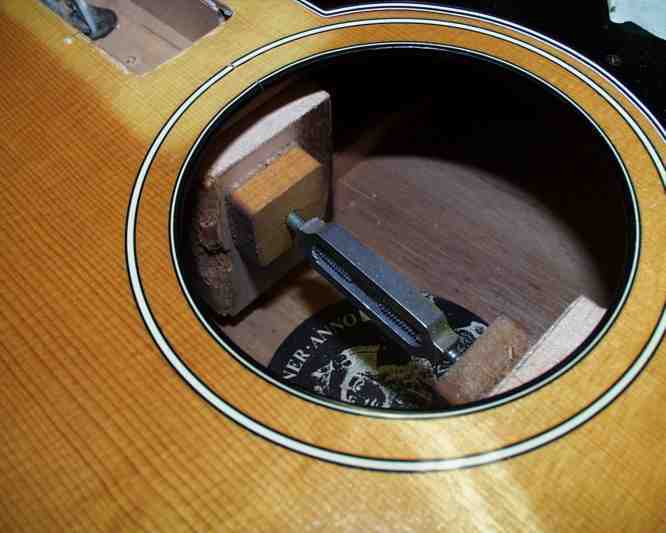 |
Now it was only necessary to remove the old glue residues, spread the loose spots with wedges and prepare for gluing. So that the gluing does not fail again, I plan to pre-drill and secure the ceiling with 4 screws 3x12. After all this is done, the gluing can start.
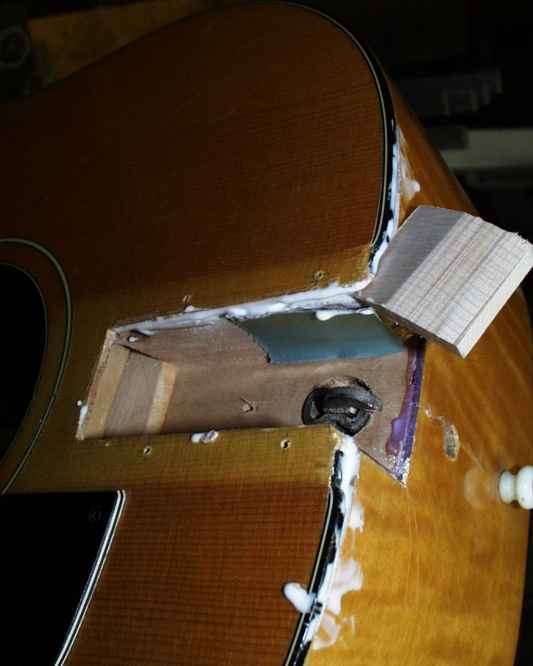 |
 |
The excess glue must be removed, the screws tightened and left to dry overnight.
 |
As mentioned above, the neck angle is determined by the position of the steel pin. After removing the clamps and removing the remaining glue, insert the neck check the alignment across the fret bars with a ruler. Ideally, the ruler will hit the top of the bridge. Depending on whether the neck is stiff or soft, this may be off by 1-1.5mm from ideal. I carved away the shortfall above the steel pin and reattached it to the underside with veneer strips.
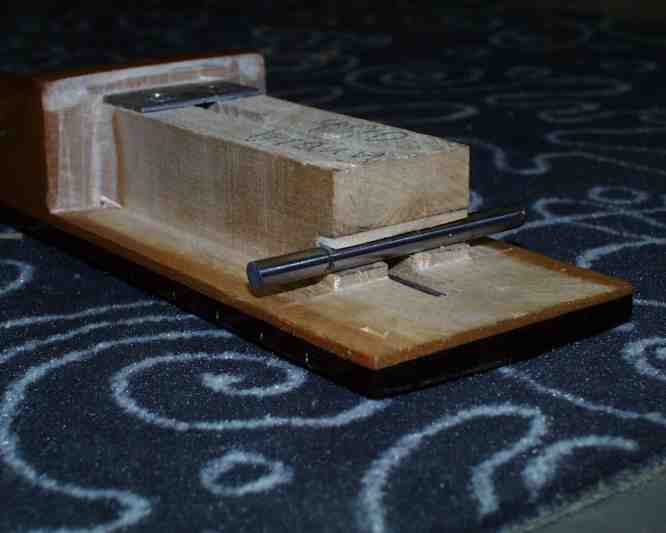 |
The soundboard lowered 3cm in front of the soundhole because a piece of wood was enclosed here. To conceal this lowering, I glued a thin maple wedge and painted it in the tone of the top.
 |
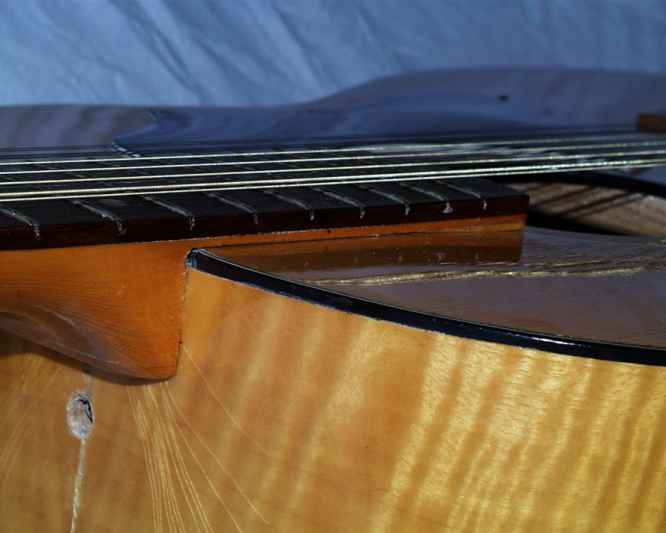 |
Now everything was done. The tuners and fingerboard were cleaned and oiled, new saddles were put on and the whole thing was ready to play. After such a long time, wonderful tones came out of the good Höfner again. Here are two more pictures of the whole guitar:
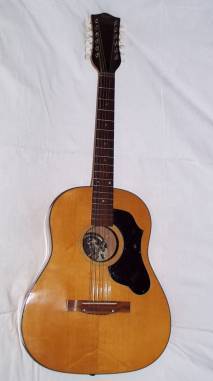 |
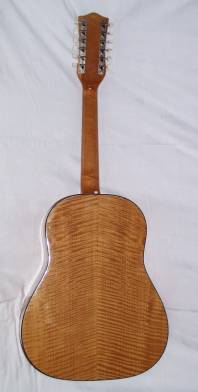 |
|
Rall Guitars & Tools Hauptstrasse Tel +49 (0) 8803-48856-56 Retail Shop: By appointment only |
Subscribe our Newsletter By subscribing our newsletter you accept our Privacy Policy and Terms and Conditions. |



